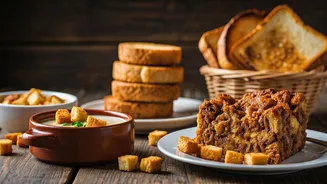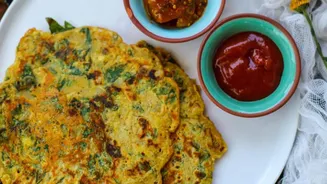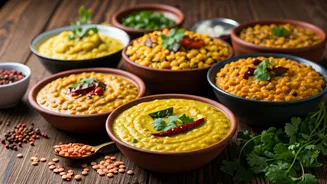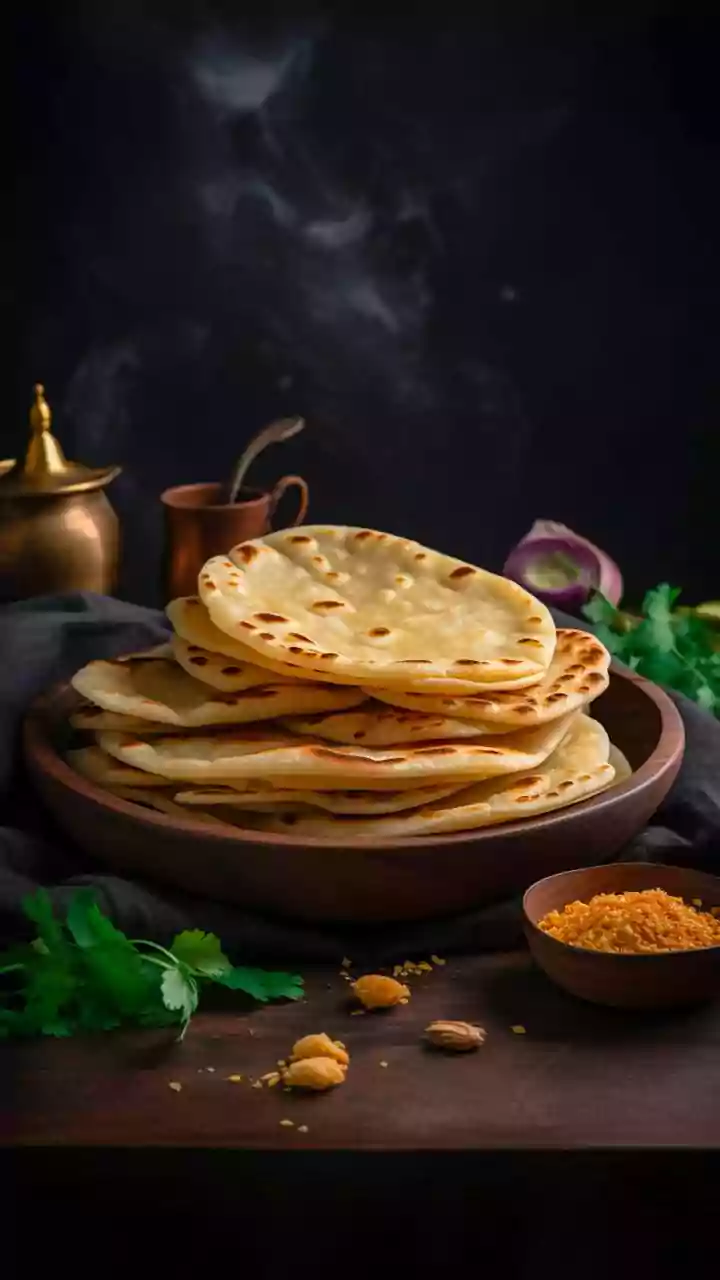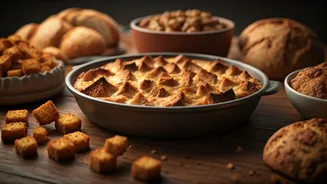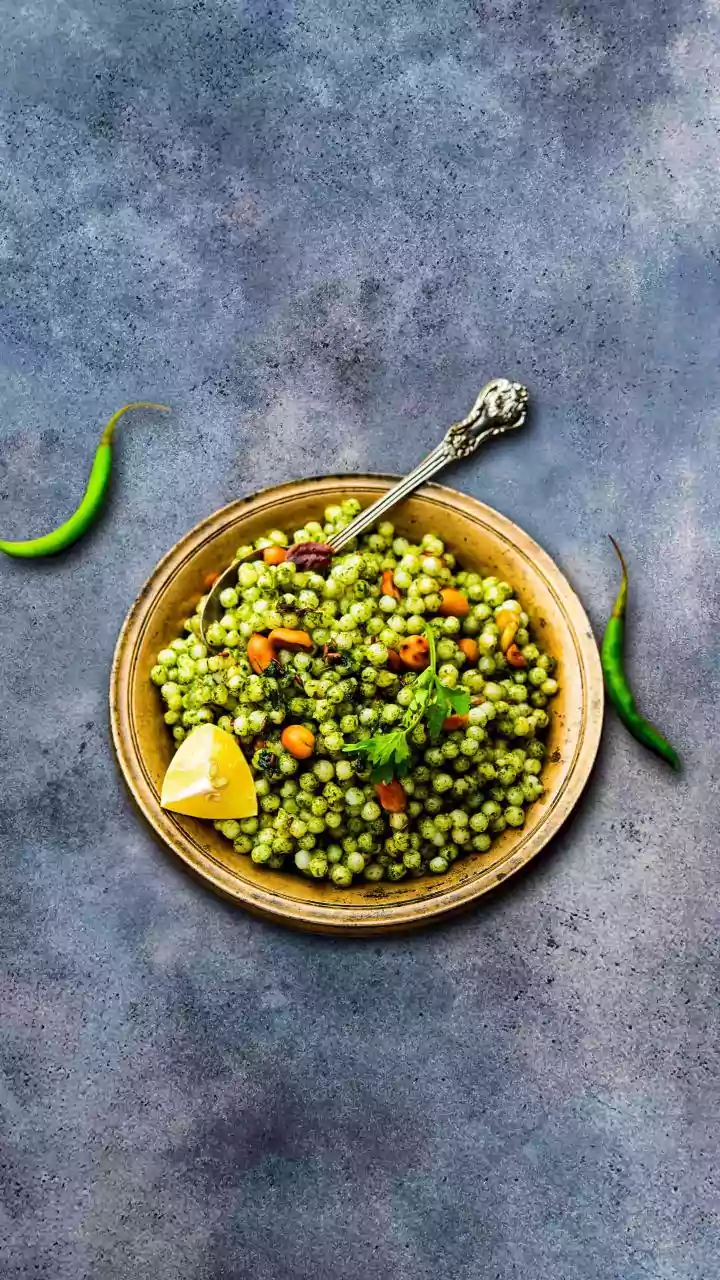Croutons: Savory Crunch
One excellent use for aging bread is making homemade croutons, offering a delightful crunch to soups and salads. Begin by cubing your stale bread into
bite-sized pieces. Toss the bread cubes with olive oil, ensuring they're evenly coated. Enhance the flavor with your favorite herbs and spices, such as garlic powder, Italian seasoning, or a pinch of salt and pepper. Spread the bread cubes on a baking sheet and bake them in a preheated oven at around 350°F (175°C) until they turn golden brown and crispy, typically taking about 10-15 minutes, but keep a close eye to prevent burning. Homemade croutons not only add texture and flavor to your dishes but also significantly reduce food waste, making them a delicious and sustainable choice. This method is exceptionally easy, making it perfect for both novice and experienced cooks. Experimenting with different seasonings can customize the croutons to match the specific flavors of your meals. The homemade touch makes all the difference compared to store-bought varieties, ensuring a fresh and flavorful addition to your meals.
Breadcrumbs: Culinary Versatility
Turn stale bread into breadcrumbs, a versatile ingredient that enhances many recipes. To make breadcrumbs, you can use the oven or a food processor. For the oven method, simply dry out the bread until it's very hard. Then, pulse the dried bread in a food processor until it reaches your preferred crumb size, or you can crush it by hand. Alternatively, toast the bread slices and then let them cool before you crush them. Breadcrumbs are excellent for coating chicken cutlets, adding texture to meatloaf, or thickening soups and sauces. You can also mix them with herbs and spices for breading vegetables before frying or baking. Consider using different types of bread to create various flavors of breadcrumbs. For example, using whole-wheat bread will give you more nutritional value. Storing breadcrumbs in an airtight container extends their usability, allowing you to have a readily available ingredient whenever needed. By making breadcrumbs, you are not only saving food but also adding depth to your cooking repertoire.
French Toast: Classic Delight
Transforming stale bread into French toast is a delicious way to revitalize it, offering a classic breakfast or brunch option. The slightly drier texture of stale bread absorbs the egg mixture beautifully, resulting in a more flavorful and less soggy outcome. Prepare a custard-like mixture by whisking eggs with milk (or cream for a richer flavor), a dash of vanilla extract, and a pinch of cinnamon. Dip the bread slices into this mixture, ensuring they're fully soaked but not overly saturated. Then, cook the soaked bread slices on a lightly buttered griddle or skillet over medium heat until golden brown on both sides. Serve your French toast with your favorite toppings, such as maple syrup, fresh berries, whipped cream, or a dusting of powdered sugar. French toast is a fantastic way to use up different types of bread, allowing you to experiment with flavors and textures. The combination of sweet and savory elements makes it a crowd-pleaser for any occasion, and it's also a quick and easy dish to prepare, making it ideal for busy mornings. This recipe offers a delightful blend of simplicity and taste, turning leftovers into something special.
Bread Pudding: Comfort Food
Embrace the comfort of bread pudding as a perfect way to utilize stale bread, transforming it into a warm and satisfying dessert. Bread pudding is known for its versatility, offering numerous opportunities to experiment with flavors and ingredients. Start by cubing the bread and letting it dry out slightly, or toasting it lightly for added texture. Soak the bread cubes in a mixture of milk or cream, eggs, sugar, and vanilla extract; you can also add spices such as cinnamon and nutmeg. Layer the bread mixture in a baking dish, and include ingredients like raisins, chocolate chips, or nuts for extra flavor and texture. Bake the bread pudding in the oven until the top is golden brown and the custard is set, generally at 350°F (175°C). Bread pudding is a versatile dessert that provides a fantastic way to avoid food waste, while allowing you to enjoy a comforting and flavorful treat. The variations are endless, from adding fruits like apples or bananas to incorporating chocolate or caramel for a richer flavor profile, making it a beloved dish.
Panzanella: Italian Salad
Panzanella, an Italian bread salad, offers a refreshing and flavorful way to breathe new life into stale bread, especially during the warmer months. The bread absorbs the flavors of the dressing and other ingredients, becoming tender yet still maintaining a pleasant texture. Begin by cubing the stale bread and toasting it slightly, either in the oven or in a pan. In a large bowl, combine the bread with fresh, ripe tomatoes, cucumbers, red onions, and any other desired vegetables. Create a flavorful dressing using olive oil, red wine vinegar, salt, pepper, and sometimes a touch of garlic or herbs. Toss the salad gently to allow the bread to soak up the dressing. Let it sit for a while, allowing the bread to soften and absorb the flavors, before serving. Panzanella is an excellent recipe for using up not only stale bread but also other fresh vegetables that might be on their way out. The combination of textures and flavors makes it a perfect light meal or side dish, and the simple preparation makes it ideal for home cooks.
Stuffing: Savory Side Dish
Making stuffing or dressing is a classic way to use up stale bread, perfect for a holiday feast or any special meal. The drier texture of stale bread is ideal for absorbing the savory flavors of the broth and seasonings, creating a rich and flavorful dish. Begin by cubing the bread and allowing it to dry out, sometimes toasted for additional texture. Sauté aromatic vegetables like onions, celery, and garlic in butter or olive oil. Combine the bread with the vegetables, add herbs such as sage, thyme, and rosemary, and moisten with chicken or vegetable broth. Season the mixture well with salt and pepper. Bake the stuffing in the oven until it is golden brown and crispy on top, or cook it inside the cavity of a bird. Stuffing offers a delicious and efficient way to reduce food waste, making it a practical and flavorful addition to the dinner table. This recipe offers considerable versatility, allowing for variations according to individual preferences, and easily adapting to suit vegetarian or vegan diets.
